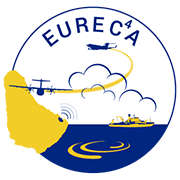28 Jan
As you already know from yesterday's post of Sandrine, shallow clouds can organize to patterns that are quite different to the first thoughts of trade wind cumuli being randomly distributed.
Their organization reach at times to Orlanski's meso-scale alpha (200 km) scale, which makes it difficult to observe these structures. Imagine trying to deduce this structure from ground-based photographs or even an air plane which only flies at an altitude of just 2.5 km as was the case of Malkus and Riehl's (1963) study over the Pacific, or in simulations whose entire domain is only 2 km as in the first LES studies (well and many LES persist in using very small domains). To give you a sense of the general extent of shallow cloud structures measured with a radar at the Barbados Cloud Observatory, I have compiled some images using our radar. Despite the challenges they faced, Malkus and her colleagues made some impressive distinctions between several cloud appearances.
Close to the “flower” pattern is the category of “Inversion-dominated: Trade wind cumulus spreading out into strato-cumulus, definite signs of stratiform cloud but total sky cover less than about one-half”
However, as seen in the flower example (23/03/18) in the second attachment, the stratiform cloud layers can have an extreme extent and cover the Barbados Cloud Observatory for hours, and are associated with cloud coverages of much more than one-half. As noted by Dave Winker and Bjorn Stevens during last year’s preEUREC4A phase, these stratiform layers become thin enough to be penetrable by a lidar, which raises the question, how they can survive for several hours and what their radiative impacts might be.
The University of Washington group (around Robert Wood, Kuan-Ting O and Chris Bretherton) have been looking at this question (and their papers influence our thinking) as they try to explain the stratiform-layers which also occur in the transition from the stratocumulus to cumulus regime in the eastern part of e.g. the Atlantic, although in their case the Pacific (during the CSET field study).
I can’t help wondering if there are benefits for the clouds to form a “flower” besides pleasing Sandrine? What sets stratiform layers without a mesoscale organization apart from those in which a structure is apparent? Would you have guessed the mesoscale organization in which the cumulus clouds with a stratiform extent are embedded, just from the ground-measurements below? The stratiform cloud on the 23/03/18 was actually a single flower, while the example from the 10/02/17 was part of a flower meadow. What sets them apart? So you see I have something to do for my dissertation.
Without aircraft or satellites, we are clueless. Nevertheless, with high-resolution geostationary satellites, the cloud scene can nowadays be evaluated every 15 minutes from space. This is an incredible achievement, but one question still remains. Who is classifying these scenes. Well, this is a whole other story (stay tuned), but I can tell you that a large group of people at LMD and MPI (with obviously little better to do) classified 10000 satellite images (four times each) and build a valuable dataset of classified cloud patterns. With the classifications at hand, we can associated observed scenes at the Barbados Cloud Observatory with one or the other, or no, pattern, and try to get insights on their dynamics from our measurements.
We can also formulate more generic questions, such as when do we even see these flowers? This is one of many questions we are working to address by teaching some machines to emulate the scientists at MPI and LMD and which you will hear more about our work from Stephan Rasp later in this preEUREC4A season. Let’s hope for a blooming campaign!
Regarding the cloud beard-post from day 6, I got some feedback from Rob and Brad and I would like to share the discussion with you.
How well can we measure the LCL?
Rob raised this question and mentioned that the surfaced-based LCL measurements get affected by the local surface heating. This is true, we have the same problems with the LCL and sometimes it differs a lot. Nevertheless, in the plot and in our paper, I made sure that the LCL is accurate by comparing it with Ceilometer measurements. This also revealed that for our radar a threshold of -50dBZ is usually a good indicator for the cloud base height.
Why do the echoes not reach below 400 m? Is the radar dead zone really that large?
The radar dead zone is between 0 and 156 m. Anyhow, we cannot see the hygroscopically grown sea salt particles between 156 and ~400 m, because they are not large and/or spherical enough in this altitude range to be detected by the radar. The figure below shows x-ray measurements from Zeng et al. (2013), which indicates that sea salt particles need higher relative humidities to form spherical droplets.
